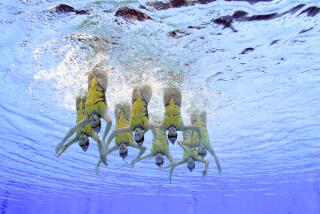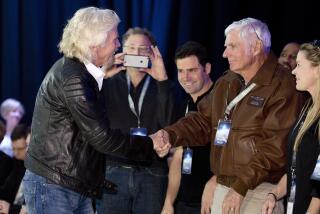Evelyn ‘Bobbi’ Trout, 97; Record-Setting Aviatrix of the 1920s
Evelyn “Bobbi” Trout, a record-setting pioneer woman aviator and the last surviving participant in the first women’s transcontinental air race in 1929, has died. She was 97.
Trout, a charter member of the Ninety-Nines, a women’s flying organization, died of a heart attack Friday at Scripps Memorial Hospital in La Jolla.
Dubbed “Bobbi” after she adopted the stylishly bobbed hairdo that was the rage at the time, Trout began taking flying lessons in Los Angeles in early 1928. Within eight months of soloing, the 22-year-old Trout was generating front-page newspaper headlines for setting women’s endurance flight records.
On Jan. 2, 1929, a few months after landing a $35-a-week job demonstrating a new high-wing monoplane called the Golden Eagle, Trout took off from Van Nuys Airport. When she touched down after circling the airport for 12 hours and 11 minutes, she had broken the previous women pilots’ solo endurance record of eight hours.
“When women did something in those days it was quite extraordinary,” Trout said decades later. “People thought they were either crazy or doing something wonderful.”
Her 1929 triumph was short-lived -- Elinor Smith beat Trout’s time by an hour a few weeks later. But Trout proceeded to set a new record of 17 hours and 24 minutes. In the process, she logged the first all-night flight by a woman.
In a 1990 interview with The Times, Trout recalled rubbing her neck and singing to pass the hours. But engulfed in darkness and bored by the monotonous drone of her plane’s 60-horsepower engine, she said: “I went to sleep a few times, and when I went into a dive, the engine awakened me.”
In 1929, Trout also broke the woman’s altitude record for light-class aircraft by climbing to 15,200 feet. And teamed up with Smith, she set yet another world endurance record in 1929 of 42 hours, 3 1/2 minutes in what was the first women’s in-flight refueling operation: Trout leaned out of the plane to catch bags of food, motor oil and a 25-foot rope attached to a gasoline hose lowered from the refueling plane.
In a second effort, with Edna May Cooper in 1931, Trout set a new women’s refueling endurance record: 122 hours, 50 minutes. And in 1930, Trout became the fifth woman in the U.S. to earn a transport license, allowing her to fly for hire. However, airlines at the time didn’t employ women pilots.
“She was a tremendous American aviation pioneer,” said Bruce Bleakley, executive director of the San Diego Aerospace Museum, which features Trout in its “Women in Aviation” exhibit. “She served as an inspiration to a lot of ladies back in those days and even later on.”
In a 1990 interview with The Times, Peggy Baty, then associate dean of academics at Embry-Riddle Aeronautical University in Prescott, Ariz., said Trout belonged to a small group of the most courageous early women fliers.
“In the ‘20s and ‘30s, I see four names: Amelia Earhart, Louise Thaden, Bobbi Trout and [Florence] Pancho Barnes,” Baty said.
Another admirer was Air Force Lt. Col. Eileen Collins, who took Trout’s old pilot’s license, along with a scarf that once belonged to Trout’s friend, Earhart, into space in 1994 when Collins became the first female space shuttle commander.
Born in 1906 in Greenup, Ill., Trout was 12 the first time she saw an airplane aloft.
“I said, ‘That’s what I’m going to do some day,’ ” she recalled in a 1999 interview with The Times. Her family settled in Southern California in 1920, and Trout had her first airplane ride in a Curtiss Jenny two years later when she was 16.
Always adept with mechanics -- she wasn’t allowed to take manual arts training courses “with the boys” in high school and lamented about having to take a “sissy” cooking class -- she talked her parents into buying a service station for her to run. By 1928, she had saved enough money to pay for flying lessons.
During one lesson, her instructor took the controls and made an error that caused the open-cockpit Curtiss Jenny to spin 100 feet into a field.
“I landed in the hospital, and on the front page of the paper it said, ‘Girl Spins In,’ ” Trout told the San Jose Mercury News in 1994. “My mother saw that and just about had a heart attack. She asked me to give up flying.”
Trout wouldn’t think of it.
“Why should I give it up? I’ll never know if I’ve been killed,” she remembered replying. “I loved to fly that old Jenny.”
In 1929, Trout joined Earhart, Barnes and 17 other participants in the first All-Women’s Transcontinental Air Race from Santa Monica to Cleveland. Humorist Will Rogers dubbed it the Powder Puff Derby and the name stuck. Trout made it to Cleveland, although her engine quit twice and she was forced to make emergency landings that put her out of the running.
With a scarcity of flying jobs during the Depression, Trout became a flying instructor and, in the late ‘30s, a commercial photographer.
With Barnes, she formed the Women’s Air Reserve to transport emergency supplies and personnel in disasters. She also served in the Civil Air Patrol and started two aviation-related businesses to aid the war effort: She invented a machine to sort unused rivets that were being scrapped by aircraft companies, and she developed de-burring equipment for smoothing the edges of machined metal.
Trout, who never married, later sold real estate in the Palm Springs area. She retired to Carlsbad in 1976.
A celebration of Trout’s life will be held at the March 20-22 Women in Aviation Conference in Cincinnati.






